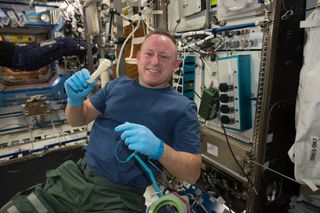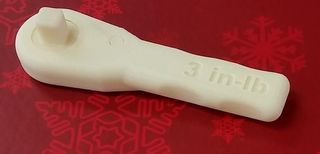
The 3D printer aboard the International Space Station has wrapped up the first phase of its orbital test run by cranking out a ratchet wrench whose design was beamed up from Earth.
The wrench, along with the 19 other objects built by the orbiting 3D printer thus far, will travel to Earth early next year, where engineers will compare the objects with ground samples produced by the same machine before it launched, NASA officials said.
"We can't wait to get these objects home and put them through structural and mechanical testing," Quincy Bean, of NASA's Marshall Space Flight Center in Huntsville, Alabama, said in a statement. "We really won't know how well this process worked in space until we inspect the parts and complete these tests." [10 Ways 3D Printing Could Transform Space Travel]
The 3D printer arrived on the space station in September as part of the 3D Print project, a collaboration between NASA and the California-based startup Made in Space, which designed and built the machine. The printer was installed in the station's Microgravity Science Glovebox on Nov. 17, then printed out its first part — a piece for the printer itself called an extruder plate — a week later.
All the other parts made by the printer during its first month of operations came from designs installed on the machine before its launch. So sending the wrench's file up from Earth marked another milestone, NASA officials said.
"For the printer's final test in this phase of operations, NASA wanted to validate the process for printing on demand, which will be critical on longer journeys to Mars," 3D Print program manager Niki Werkheiser, also of NASA Marshall, said in the same statement. "In less than a week, the ratchet was designed, approved by safety and other NASA reviewers, and the file was sent to space where the printer made the wrench in four hours."

The wrench measures 4.5 inches long by 1.3 inches wide (11.4 by 3.3 centimeters), and consists of 104 layers of extruded plastic, space agency officials said.
Get the Space.com Newsletter
Breaking space news, the latest updates on rocket launches, skywatching events and more!
NASA has high hopes for 3D printing, saying in-space manufacturing technology could bring down the cost of spaceflight significantly and make voyaging spacecraft more self-sufficient. (Carrying a printer and some raw "feedstock" material would be easier and cheaper than lugging a huge cache of spare parts, the thinking goes.)
The 3D Print project is one step toward this ambitious goal. And the machine's work aboard the space station isn't done yet; phase two should start early next year.
"For our next phase of operations, we are working with the astronaut office to identify existing tools that we can make with the printer," Werkheiser said. "We can't wait until it is routine to see station astronauts use tools that they built in space."
Follow Mike Wall on Twitter @michaeldwall and Google+. Follow us @Spacedotcom, Facebook or Google+. Originally published on Space.com.
Join our Space Forums to keep talking space on the latest missions, night sky and more! And if you have a news tip, correction or comment, let us know at: community@space.com.

Michael Wall is a Senior Space Writer with Space.com and joined the team in 2010. He primarily covers exoplanets, spaceflight and military space, but has been known to dabble in the space art beat. His book about the search for alien life, "Out There," was published on Nov. 13, 2018. Before becoming a science writer, Michael worked as a herpetologist and wildlife biologist. He has a Ph.D. in evolutionary biology from the University of Sydney, Australia, a bachelor's degree from the University of Arizona, and a graduate certificate in science writing from the University of California, Santa Cruz. To find out what his latest project is, you can follow Michael on Twitter.
Most Popular

